Unit 1 This is me!考点复习课件七年级英语上学期(牛津译林版)(共33张PPT)
文档属性
| 名称 | Unit 1 This is me!考点复习课件七年级英语上学期(牛津译林版)(共33张PPT) | 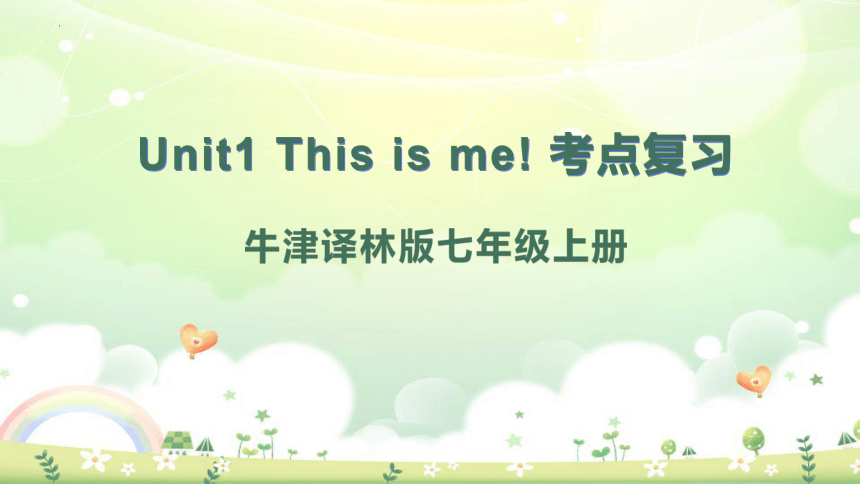 | |
| 格式 | pptx | ||
| 文件大小 | 458.5KB | ||
| 资源类型 | 教案 | ||
| 版本资源 | 牛津译林版 | ||
| 科目 | 英语 | ||
| 更新时间 | 2023-10-07 21:28:30 | ||
图片预览




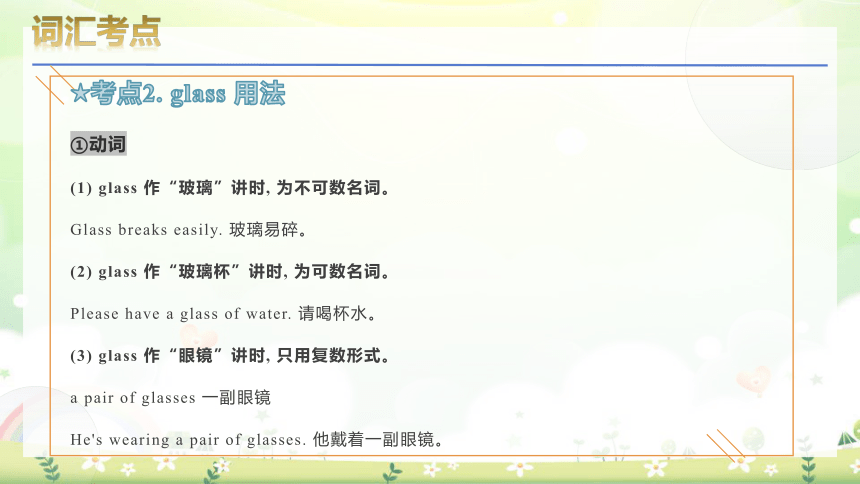

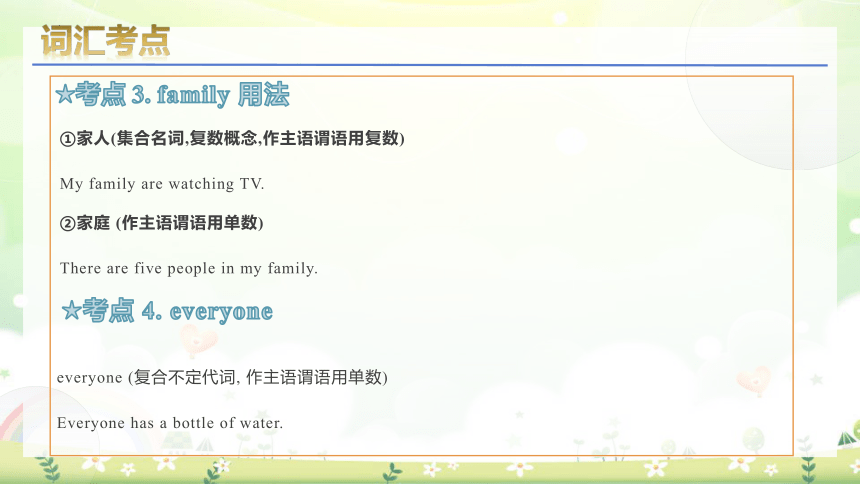
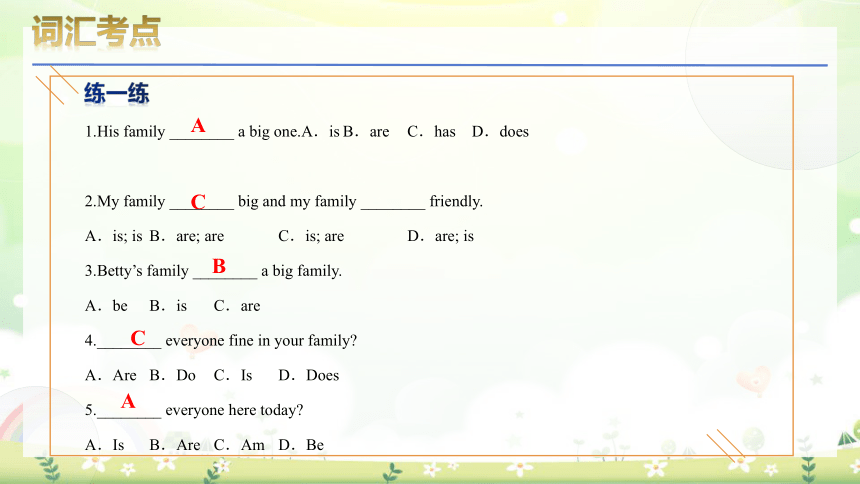

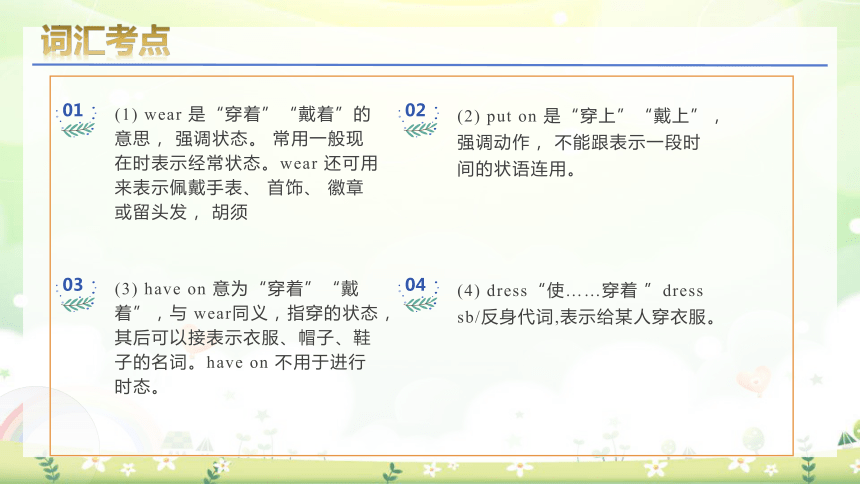
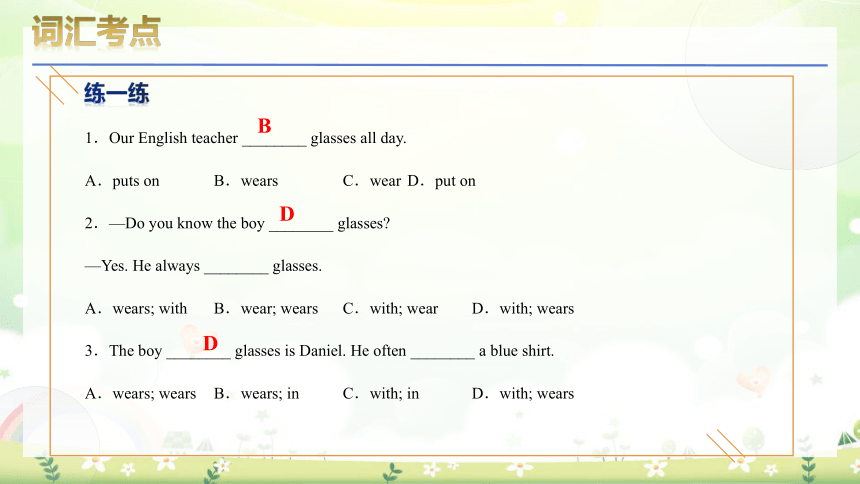

文档简介
(共33张PPT)
Unit1 This is me! 考点复习
牛津译林版七年级上册
01
词汇考点
词汇考点
★考点 1. look 用法
①动词
1.单独使用, 通常用于句首。
Look! Here comes the bus. 瞧!汽车来了。
2.用作连系动词, 后接形容词“看起来”。
You look well/fine/healthy. 你看起来很健康。
3.短语搭配:
look at 看; look for 寻找; look out of 向外看; look after 照看, 照料
look around 四下环顾, 到处寻找 ;look out =watch out 小心; look like 看起来像
词汇考点
4.常考区分:
②名词
1.表情(通常用单数) the look of joy 高兴的表情
2.相貌;容貌 (通常用复数)
look vi.强调看的动作或过程,接宾语要加at Look at the pictures.
see vt. 看见,看到,看(医生/朋友/电影) see a doctor 看医生see a film/movie 看电影
watch vt. 观看(球赛/电视/电影) watch a movie/film 看电影watch a football match 看足球比赛
read vt. 阅读;看(书/报/杂志) read the book/newspaper/magazine读(看)书、报纸、杂志
词汇考点
★考点2. glass 用法
①动词
(1) glass 作“玻璃”讲时, 为不可数名词。
Glass breaks easily. 玻璃易碎。
(2) glass 作“玻璃杯”讲时, 为可数名词。
Please have a glass of water. 请喝杯水。
(3) glass 作“眼镜”讲时, 只用复数形式。
a pair of glasses 一副眼镜
He's wearing a pair of glasses. 他戴着一副眼镜。
词汇考点
1.Look! My mum is cooking the fish soup. Mm, it ________ very delicious.A.tastes B.looks C.smells D.feels2.— What ________ your best friend like — He is helpful and ________ his mother very much.A.does; likes B.does; look like C.is; looks like D.is; likes3.—________ Amy happy today —I think so. She ________ happy today.A.Does; looks B.Does; look C.Is; look D.Is; looks
练一练
B
C
D
★考点 3. family 用法
①家人(集合名词,复数概念,作主语谓语用复数)
My family are watching TV.
②家庭 (作主语谓语用单数)
There are five people in my family.
词汇考点
everyone (复合不定代词, 作主语谓语用单数)
Everyone has a bottle of water.
★考点 4. everyone
词汇考点
练一练
1.His family ________ a big one.A.is B.are C.has D.does
2.My family ________ big and my family ________ friendly.
A.is; is B.are; are C.is; are D.are; is
3.Betty’s family ________ a big family.
A.be B.is C.are
4.________ everyone fine in your family
A.Are B.Do C.Is D.Does
5.________ everyone here today
A.Is B.Are C.Am D.Be
A
C
B
C
A
词汇考点
拓展:复合不定代词代词表格:
复合不定代词 some any no every
thing something anything nothing everything
one someone anyone no one everyone
body somebody anybody nobody everybody
★考点 5. “穿”的表达方式
(1) wear 是“穿着”“戴着”的意思, 强调状态。 常用一般现在时表示经常状态。wear 还可用来表示佩戴手表、 首饰、 徽章或留头发, 胡须
01
(2) put on 是“穿上”“戴上”, 强调动作, 不能跟表示一段时间的状语连用。
02
(3) have on 意为“穿着”“戴着”,与 wear同义,指穿的状态,其后可以接表示衣服、帽子、鞋子的名词。have on 不用于进行时态。
03
(4) dress“使……穿着 ”dress sb/反身代词,表示给某人穿衣服。
04
词汇考点
词汇考点
练一练
1.Our English teacher ________ glasses all day.
A.puts on B.wears C.wear D.put on
2.—Do you know the boy ________ glasses
—Yes. He always ________ glasses.
A.wears; with B.wear; wears C.with; wear D.with; wears
3.The boy ________ glasses is Daniel. He often ________ a blue shirt.
A.wears; wears B.wears; in C.with; in D.with; wears
B
D
D
02
短语考点
短语考点
1. the master of=one's master ... 的主人
2. look after= take care of 照顾, 照看, 保管
3. read the book/newspaper/magazine读(看)书、报纸、 杂志
4. the first day 第一天
5. on the first day 在第一天
6. in the morning/afternoon/evening; at night 在早晨、 下午、 晚上; 晚上
7. over there 在那边 (补充: all over the world 全世界)
8. go swimming 去游泳
9. at the age of 在…岁的时候
短语考点
11. live with sb in sp 和某人居住在某地 live with family in Beijing
12. all the lessons 所有课程(all 三者或三者以上; 两者都用both)
13. after school 放学后 after class 下课后 after-school activities 课外活动
14. be from = come from 来自 Where is he from Where does he come from
15. tall and slim 又高又瘦
16.. be good at (doing) 擅长于 (= do well in)
17. in Class One, Grade Seven 七年级一班
18. like/ love doing sth.喜欢/喜爱做某事。表示习惯性动作
like/love to do sth. 表示一次性尝试或者想做还没有做的动作
19. How to do sth. 如何做某事。
词汇考点
练一练
1.它喜欢水,是游泳高手。
It likes water and is_________________ swimming.
2.每天放学后,我和同学们踢足球。
I play soccer with my classmates _________________ every day.
3.你放学后经常做什么?
What do you often do_________________
4.你的表兄弟又矮又瘦吗?
__________ your _____________ short and ___________
5.我的两个朋友来自于澳大利亚。
Two of my friends_________________ Australia.
good at
after school
after school
Is cousin thin
are/come from
03
语法 (含有 be 动词的一般现在时)
短语考点
我们常用动词 be的一般现在时谈论事实和状态。
一、一般现在时的使用范围。1. 表示现在的状态。例如: I'm twelve. 我十二岁。2. 表示经常或者习惯性的动作。例如: I have lunch every day. 我每天吃午饭。3. 表示客观事实或者存在。例如: My sister is a teacher. 我姐姐是一位老师。
4. 表示主语所具备的性格和能力。例如: She likes English very much. 她很喜欢英语。
二、一般现在时的标志词。一般现在时态经常与 often (经常) , sometimes (有时) , always (总是) , usually (通常)等副词连用, 也经常与 every day(每天), every week(每周), every month (每月),every term (每学期) , every year (每年) , once a week (一周一次) , twice a year (一年两次)等时间状语连用。例如: She gets up early every morning. 她每天早上早起。I go to see my grandmother every month. 我每个月都去看我的奶奶。
注意:频度副词要放在谓语动词之前助动词之后。
短语考点
语法考点
be动词包括“am,is,are”,中文意思为“是”。这三个词的用法要随着主语的变化而变化。“am”用于第一人称单数 (I) ;“is”用于第三人称单数 (he, she, it) , 以及单数可数名词或者不可数名词前;“are”用于第一人称复数 (we) ,第二人称单数和复数(you),第三人称复数 (they)。
考点1. 缩写
A:主语+be, 缩写be第一个字母为’, 再与主语合并。
I am=I'm he is=he's she is=she's it is=it's we are=we're
you are=you're they are=they're Mary is=Mary's here is=here's that is=that's
B: be+not 否定形式缩写, 缩写 not 中o为’, 再与 be 合并。
is not=isn't are not= aren't
注意:一般疑问句的肯定回答中,主语和be动词不能缩写
语法考点
1.To the south of the pool ________ plenty of green trees and flowers.A.have B.has C.are D.is
2.—There _______ a pair of gloves on the desk. ________ yours —Yes, thank you.A.is; Is it B.are; Are they C.are; Is it D.is; Are they
3.The girl with her parents over there ________ Millie.A.be B.am C.is D.are
练一练
C
D
C
语法考点
考点 2.否定句的变化规律
主系表结构中在 be 动词之后+not,句子其它部位不变。
He isn't a teacher. 他不是老师。
This isn't a book.这不是一本书。
1.There________ a desk and thirty chairs in it.(be not)2.My favorite lessons ________ maths and English.(be not)3.There _________ any bread and a hot dog on the table.(be not)
练一练 用所给词的适当形式填空
isn’t
aren’t
isn’t
语法考点
考点 3.一般疑问句的变化规律:
1.找be动词
2.be动词提前
3.some变any;and变or
4.人称一变二,句号变问号
一般疑问句的回答:
肯定回答:Yes,主语+be.
否定回答:No,主语+be+not.
注意:1.前肯后肯,前否后否;Yes,it is./No,it isn't.2.第二人称问,第一人称答;
Are you a teacher Yes,I am.3.主语必须用代词回答; Is Lucy a teacher Yes, she is.4.肯定回答不能缩写; Yes, I am.
语法考点
练一练
1.—________ your mother free this weekend —No. She has a lot of housework to do.A.Does B.Are C.Do D.Is
2.—________ your name Michele
—________.
A.Is; Yes, I am B.Is; Yes, it is C.Are; Yes I am D.Are; Yes, it is
3.________ one of Sandy’s cousins ________ from America
A.Are; / B.Is; comes C.Are; come D.Does; come
D
A
D
04
重点句子
1. How to look after your e-dog 如何照顾你的电子狗 2. What's your name My name is ……/I am…… 请问你叫什么名字 我叫……3. Let's/let us meet my new classmates. 让我们见见我的新同学。4. Her hair is long.= She has long hair. 她的头发很长/她有长长的头发/她长着长头发。5. She likes reading.= Reading is her hobby. 她喜欢读书/读书是她的爱好。
句子考点
句子考点
6. Gla d to see/meet you = Nice to see/meet you. 很高兴见到你。7. She is good at dancing.=She is a good dancer.= She dances well.她擅长跳舞/她是个很好的舞者/她跳舞跳的很好。8. I live with my family in Beijing. 我和我家人生活在北京9.I like all the lessons at Sunshine Middle School.我喜欢阳光中学的所有课程。10. What/Which grade/class are you in 你在哪个年级/班级
05
重点考点
知识点考点
1.e-dog 的发音以元音音素开头,所以一只电子狗:an e-dog,复数形式:e-dogs
2.master n. 主人 复数形式:masters. v. 精通,掌握
3.read,look, see 和watch 的区别
read Look see watch
read指“看”,实指“阅读”,看有文字的材料,常用于看书、看报等。 不及物动词,意为“看,瞧”强调看的动作,如果要跟宾语,与at连用。look at meLook at the blackboard. 意为“看到”,强调看的结果 意为“观看,注视”常用于看电视,看球赛,看演出
I like reading at home. Look, what’s that Look, can you see a kite in the sky I don’t like reading books, I like watching TV.
知识点考点
4.look after = take care of 照顾,照看 look after well = take good care of 好好照顾
拓展:与look 相关的动词短语
look like 看起来像 look for 寻找 look up 查阅
look out 当心 look at 看 look through 浏览
5.welcome,动词,意为“欢迎”,常用于对别人表示欢迎。welcome to 是固定结构,意为“欢迎来到”,后接表示地点的词,若所接地点是副词,则省略介词to。
6. Class 1, Grade 7 意为“七年级一班”,也可写作Class One, Grade Seven。英语中当 class 和 grade后与数字连用时,class 和 grade 的首字母要大写,后面的数字用英文单词表达时,该数字的首字母也要大写,在英语中有类似用法的单词还有 number, lesson, unit,group, room 等。
【拓展】对班级或年级提问用“What/Which class/grade...in ”。 7. 表示年龄常用“基数词+ year(s) + old”结构,意为“……岁”,在日常交流中也可将 year(s) old 省略;对年龄提问用疑问短语 how old,表示“多大年纪”。
知识点考点
8. love通常作及物动词,意为“喜爱”,后接名词、动名词或动词不定式。
【拓展】若要加强喜爱的程度,不能用 very修饰,而通常用very much 修饰。
9.let,动词,意为“让;使”。let's 后接动词原形,意为“让我们……”,表示征求对方的意见、向对方提出建议或与对方一起去做某事。
【拓展】let's 与 let us
let's do sth.指包括说话人在内,表示“咱们去做某事吧”,即提出建议、劝对方一同做某事;let us do sth.表示“让/允许我们做某事”,即提出请求并请对方允许,而对方不做,只有“我们”做。
10.after school 意为“放学后”,其中 after是介词,意为“在……之后”,通常用于强调时间上的“以后”。
【拓展】与after school 结构类似的短语有:after class 下课后 after lunch 午饭后 after work下班后
11.play football 意为“踢足球”。结构“play +球类运动/棋类活动”表示“进行某项运动/活动”,中间不加任何冠词。
知识点考点
【拓展】①若 play 后接乐器类名词,则结构为“play +the+乐器类名词”,中间的定冠词 the 不能省略。② play with sb./sth.意为“与某人一起玩/玩某物”。
12.be good at 意为“擅长于”, at在此处是介词,其后可跟名词或动词-ing 形式,表示“擅长于(做)某事”
【拓展】① be good at =do well in = be clever at,都表示“在……方面做得好;擅长”。
②. be good for 对……有益;be good to对……友好的。
13.live,不及物动词,意为“居住”,后面不能直接跟名词,一般接表示地点的介词短语或副词。live with意为“与……住在一起”, live in some place意为“住在某地”。live 后接地点副词 here, there 等时,省略介词。
【拓展】① live后接的居住地有具体的门牌号码时,介词要用at。
② live后接的居住地是某条路或某楼层时,介词用on。
知识点考点
14.all the lessons 意为“所有课程”。结构“all the +名词”中的 all为限定词,意为“全部,所有”,可修饰可数名词和不可数名词;在名词前可加定冠词、指示代词、形容词性物主代词及基数词。all these books 所有这些书all his food 他的所有食物all the afternoon 整个下午
【拓展】英语中 all指三个或三个以上的人或事物,而指两个人或事物用 both.
Thank you!
Unit1 This is me! 考点复习
牛津译林版七年级上册
01
词汇考点
词汇考点
★考点 1. look 用法
①动词
1.单独使用, 通常用于句首。
Look! Here comes the bus. 瞧!汽车来了。
2.用作连系动词, 后接形容词“看起来”。
You look well/fine/healthy. 你看起来很健康。
3.短语搭配:
look at 看; look for 寻找; look out of 向外看; look after 照看, 照料
look around 四下环顾, 到处寻找 ;look out =watch out 小心; look like 看起来像
词汇考点
4.常考区分:
②名词
1.表情(通常用单数) the look of joy 高兴的表情
2.相貌;容貌 (通常用复数)
look vi.强调看的动作或过程,接宾语要加at Look at the pictures.
see vt. 看见,看到,看(医生/朋友/电影) see a doctor 看医生see a film/movie 看电影
watch vt. 观看(球赛/电视/电影) watch a movie/film 看电影watch a football match 看足球比赛
read vt. 阅读;看(书/报/杂志) read the book/newspaper/magazine读(看)书、报纸、杂志
词汇考点
★考点2. glass 用法
①动词
(1) glass 作“玻璃”讲时, 为不可数名词。
Glass breaks easily. 玻璃易碎。
(2) glass 作“玻璃杯”讲时, 为可数名词。
Please have a glass of water. 请喝杯水。
(3) glass 作“眼镜”讲时, 只用复数形式。
a pair of glasses 一副眼镜
He's wearing a pair of glasses. 他戴着一副眼镜。
词汇考点
1.Look! My mum is cooking the fish soup. Mm, it ________ very delicious.A.tastes B.looks C.smells D.feels2.— What ________ your best friend like — He is helpful and ________ his mother very much.A.does; likes B.does; look like C.is; looks like D.is; likes3.—________ Amy happy today —I think so. She ________ happy today.A.Does; looks B.Does; look C.Is; look D.Is; looks
练一练
B
C
D
★考点 3. family 用法
①家人(集合名词,复数概念,作主语谓语用复数)
My family are watching TV.
②家庭 (作主语谓语用单数)
There are five people in my family.
词汇考点
everyone (复合不定代词, 作主语谓语用单数)
Everyone has a bottle of water.
★考点 4. everyone
词汇考点
练一练
1.His family ________ a big one.A.is B.are C.has D.does
2.My family ________ big and my family ________ friendly.
A.is; is B.are; are C.is; are D.are; is
3.Betty’s family ________ a big family.
A.be B.is C.are
4.________ everyone fine in your family
A.Are B.Do C.Is D.Does
5.________ everyone here today
A.Is B.Are C.Am D.Be
A
C
B
C
A
词汇考点
拓展:复合不定代词代词表格:
复合不定代词 some any no every
thing something anything nothing everything
one someone anyone no one everyone
body somebody anybody nobody everybody
★考点 5. “穿”的表达方式
(1) wear 是“穿着”“戴着”的意思, 强调状态。 常用一般现在时表示经常状态。wear 还可用来表示佩戴手表、 首饰、 徽章或留头发, 胡须
01
(2) put on 是“穿上”“戴上”, 强调动作, 不能跟表示一段时间的状语连用。
02
(3) have on 意为“穿着”“戴着”,与 wear同义,指穿的状态,其后可以接表示衣服、帽子、鞋子的名词。have on 不用于进行时态。
03
(4) dress“使……穿着 ”dress sb/反身代词,表示给某人穿衣服。
04
词汇考点
词汇考点
练一练
1.Our English teacher ________ glasses all day.
A.puts on B.wears C.wear D.put on
2.—Do you know the boy ________ glasses
—Yes. He always ________ glasses.
A.wears; with B.wear; wears C.with; wear D.with; wears
3.The boy ________ glasses is Daniel. He often ________ a blue shirt.
A.wears; wears B.wears; in C.with; in D.with; wears
B
D
D
02
短语考点
短语考点
1. the master of=one's master ... 的主人
2. look after= take care of 照顾, 照看, 保管
3. read the book/newspaper/magazine读(看)书、报纸、 杂志
4. the first day 第一天
5. on the first day 在第一天
6. in the morning/afternoon/evening; at night 在早晨、 下午、 晚上; 晚上
7. over there 在那边 (补充: all over the world 全世界)
8. go swimming 去游泳
9. at the age of 在…岁的时候
短语考点
11. live with sb in sp 和某人居住在某地 live with family in Beijing
12. all the lessons 所有课程(all 三者或三者以上; 两者都用both)
13. after school 放学后 after class 下课后 after-school activities 课外活动
14. be from = come from 来自 Where is he from Where does he come from
15. tall and slim 又高又瘦
16.. be good at (doing) 擅长于 (= do well in)
17. in Class One, Grade Seven 七年级一班
18. like/ love doing sth.喜欢/喜爱做某事。表示习惯性动作
like/love to do sth. 表示一次性尝试或者想做还没有做的动作
19. How to do sth. 如何做某事。
词汇考点
练一练
1.它喜欢水,是游泳高手。
It likes water and is_________________ swimming.
2.每天放学后,我和同学们踢足球。
I play soccer with my classmates _________________ every day.
3.你放学后经常做什么?
What do you often do_________________
4.你的表兄弟又矮又瘦吗?
__________ your _____________ short and ___________
5.我的两个朋友来自于澳大利亚。
Two of my friends_________________ Australia.
good at
after school
after school
Is cousin thin
are/come from
03
语法 (含有 be 动词的一般现在时)
短语考点
我们常用动词 be的一般现在时谈论事实和状态。
一、一般现在时的使用范围。1. 表示现在的状态。例如: I'm twelve. 我十二岁。2. 表示经常或者习惯性的动作。例如: I have lunch every day. 我每天吃午饭。3. 表示客观事实或者存在。例如: My sister is a teacher. 我姐姐是一位老师。
4. 表示主语所具备的性格和能力。例如: She likes English very much. 她很喜欢英语。
二、一般现在时的标志词。一般现在时态经常与 often (经常) , sometimes (有时) , always (总是) , usually (通常)等副词连用, 也经常与 every day(每天), every week(每周), every month (每月),every term (每学期) , every year (每年) , once a week (一周一次) , twice a year (一年两次)等时间状语连用。例如: She gets up early every morning. 她每天早上早起。I go to see my grandmother every month. 我每个月都去看我的奶奶。
注意:频度副词要放在谓语动词之前助动词之后。
短语考点
语法考点
be动词包括“am,is,are”,中文意思为“是”。这三个词的用法要随着主语的变化而变化。“am”用于第一人称单数 (I) ;“is”用于第三人称单数 (he, she, it) , 以及单数可数名词或者不可数名词前;“are”用于第一人称复数 (we) ,第二人称单数和复数(you),第三人称复数 (they)。
考点1. 缩写
A:主语+be, 缩写be第一个字母为’, 再与主语合并。
I am=I'm he is=he's she is=she's it is=it's we are=we're
you are=you're they are=they're Mary is=Mary's here is=here's that is=that's
B: be+not 否定形式缩写, 缩写 not 中o为’, 再与 be 合并。
is not=isn't are not= aren't
注意:一般疑问句的肯定回答中,主语和be动词不能缩写
语法考点
1.To the south of the pool ________ plenty of green trees and flowers.A.have B.has C.are D.is
2.—There _______ a pair of gloves on the desk. ________ yours —Yes, thank you.A.is; Is it B.are; Are they C.are; Is it D.is; Are they
3.The girl with her parents over there ________ Millie.A.be B.am C.is D.are
练一练
C
D
C
语法考点
考点 2.否定句的变化规律
主系表结构中在 be 动词之后+not,句子其它部位不变。
He isn't a teacher. 他不是老师。
This isn't a book.这不是一本书。
1.There________ a desk and thirty chairs in it.(be not)2.My favorite lessons ________ maths and English.(be not)3.There _________ any bread and a hot dog on the table.(be not)
练一练 用所给词的适当形式填空
isn’t
aren’t
isn’t
语法考点
考点 3.一般疑问句的变化规律:
1.找be动词
2.be动词提前
3.some变any;and变or
4.人称一变二,句号变问号
一般疑问句的回答:
肯定回答:Yes,主语+be.
否定回答:No,主语+be+not.
注意:1.前肯后肯,前否后否;Yes,it is./No,it isn't.2.第二人称问,第一人称答;
Are you a teacher Yes,I am.3.主语必须用代词回答; Is Lucy a teacher Yes, she is.4.肯定回答不能缩写; Yes, I am.
语法考点
练一练
1.—________ your mother free this weekend —No. She has a lot of housework to do.A.Does B.Are C.Do D.Is
2.—________ your name Michele
—________.
A.Is; Yes, I am B.Is; Yes, it is C.Are; Yes I am D.Are; Yes, it is
3.________ one of Sandy’s cousins ________ from America
A.Are; / B.Is; comes C.Are; come D.Does; come
D
A
D
04
重点句子
1. How to look after your e-dog 如何照顾你的电子狗 2. What's your name My name is ……/I am…… 请问你叫什么名字 我叫……3. Let's/let us meet my new classmates. 让我们见见我的新同学。4. Her hair is long.= She has long hair. 她的头发很长/她有长长的头发/她长着长头发。5. She likes reading.= Reading is her hobby. 她喜欢读书/读书是她的爱好。
句子考点
句子考点
6. Gla d to see/meet you = Nice to see/meet you. 很高兴见到你。7. She is good at dancing.=She is a good dancer.= She dances well.她擅长跳舞/她是个很好的舞者/她跳舞跳的很好。8. I live with my family in Beijing. 我和我家人生活在北京9.I like all the lessons at Sunshine Middle School.我喜欢阳光中学的所有课程。10. What/Which grade/class are you in 你在哪个年级/班级
05
重点考点
知识点考点
1.e-dog 的发音以元音音素开头,所以一只电子狗:an e-dog,复数形式:e-dogs
2.master n. 主人 复数形式:masters. v. 精通,掌握
3.read,look, see 和watch 的区别
read Look see watch
read指“看”,实指“阅读”,看有文字的材料,常用于看书、看报等。 不及物动词,意为“看,瞧”强调看的动作,如果要跟宾语,与at连用。look at meLook at the blackboard. 意为“看到”,强调看的结果 意为“观看,注视”常用于看电视,看球赛,看演出
I like reading at home. Look, what’s that Look, can you see a kite in the sky I don’t like reading books, I like watching TV.
知识点考点
4.look after = take care of 照顾,照看 look after well = take good care of 好好照顾
拓展:与look 相关的动词短语
look like 看起来像 look for 寻找 look up 查阅
look out 当心 look at 看 look through 浏览
5.welcome,动词,意为“欢迎”,常用于对别人表示欢迎。welcome to 是固定结构,意为“欢迎来到”,后接表示地点的词,若所接地点是副词,则省略介词to。
6. Class 1, Grade 7 意为“七年级一班”,也可写作Class One, Grade Seven。英语中当 class 和 grade后与数字连用时,class 和 grade 的首字母要大写,后面的数字用英文单词表达时,该数字的首字母也要大写,在英语中有类似用法的单词还有 number, lesson, unit,group, room 等。
【拓展】对班级或年级提问用“What/Which class/grade...in ”。 7. 表示年龄常用“基数词+ year(s) + old”结构,意为“……岁”,在日常交流中也可将 year(s) old 省略;对年龄提问用疑问短语 how old,表示“多大年纪”。
知识点考点
8. love通常作及物动词,意为“喜爱”,后接名词、动名词或动词不定式。
【拓展】若要加强喜爱的程度,不能用 very修饰,而通常用very much 修饰。
9.let,动词,意为“让;使”。let's 后接动词原形,意为“让我们……”,表示征求对方的意见、向对方提出建议或与对方一起去做某事。
【拓展】let's 与 let us
let's do sth.指包括说话人在内,表示“咱们去做某事吧”,即提出建议、劝对方一同做某事;let us do sth.表示“让/允许我们做某事”,即提出请求并请对方允许,而对方不做,只有“我们”做。
10.after school 意为“放学后”,其中 after是介词,意为“在……之后”,通常用于强调时间上的“以后”。
【拓展】与after school 结构类似的短语有:after class 下课后 after lunch 午饭后 after work下班后
11.play football 意为“踢足球”。结构“play +球类运动/棋类活动”表示“进行某项运动/活动”,中间不加任何冠词。
知识点考点
【拓展】①若 play 后接乐器类名词,则结构为“play +the+乐器类名词”,中间的定冠词 the 不能省略。② play with sb./sth.意为“与某人一起玩/玩某物”。
12.be good at 意为“擅长于”, at在此处是介词,其后可跟名词或动词-ing 形式,表示“擅长于(做)某事”
【拓展】① be good at =do well in = be clever at,都表示“在……方面做得好;擅长”。
②. be good for 对……有益;be good to对……友好的。
13.live,不及物动词,意为“居住”,后面不能直接跟名词,一般接表示地点的介词短语或副词。live with意为“与……住在一起”, live in some place意为“住在某地”。live 后接地点副词 here, there 等时,省略介词。
【拓展】① live后接的居住地有具体的门牌号码时,介词要用at。
② live后接的居住地是某条路或某楼层时,介词用on。
知识点考点
14.all the lessons 意为“所有课程”。结构“all the +名词”中的 all为限定词,意为“全部,所有”,可修饰可数名词和不可数名词;在名词前可加定冠词、指示代词、形容词性物主代词及基数词。all these books 所有这些书all his food 他的所有食物all the afternoon 整个下午
【拓展】英语中 all指三个或三个以上的人或事物,而指两个人或事物用 both.
Thank you!
同课章节目录
- 预备课程
- Lesson 1 Nice to meet you !
- Lesson 2 A happy family
- Lesson 3 A nice school
- Lesson 4 You look cool !
- Lesson 5 Wonderful things
- Lesson 6 Have nice food
- Lesson 7 Enjoy our days
- Lesson 8 Let's have fun !
- Unit 1 This is me
- Unit 2 Let's play sports
- Unit 3 Welcome to our school
- Unit 4 My day
- Unit 5 Let’s celebrate
- Unit 6 Food and lifestyle
- Unit 7 Shopping
- Unit 8 Fashion
